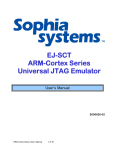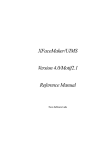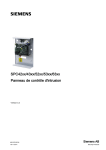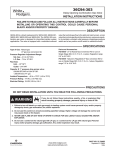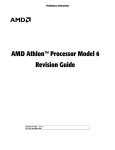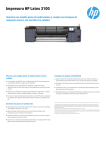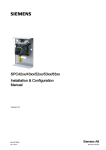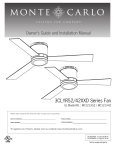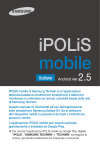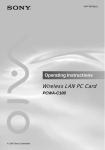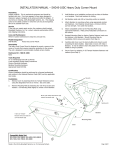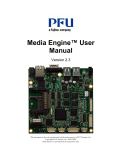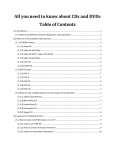Download User`s Manual - eecosales.com
Transcript
EJ-SCT SH Series H8SX Series Universal H-UID Emulator User’s Manual E090843-03 SH/H8SX Series User's Manual 1 of 81 Index 1 Technical Information and Cautions.............................................................................................5 1.1 Important Warnings and Precautions...............................................................................5 1.1.1 Operator Cautions ....................................................................................................6 1.1.2 Class A FCC Notice.................................................................................................7 2 Setup for Use With a PC...............................................................................................................8 2.1 WATCHPOINT Software Installation.............................................................................8 3 Hardware overview.......................................................................................................................9 4 Operation Modes - Development & Programming.....................................................................10 4.1 Full JTAG Emulator Development Mode......................................................................10 4.1.1 Illustration JTAG Emulator Development Mode ..................................................10 4.2 Stand-Alone JTAG FLASH Writer Mode .....................................................................10 5 About H-UID Connector.............................................................................................................11 5.1 SH/H8SX Series H-UID Cable......................................................................................11 5.2 Connecting The EJ-SCT To The Unit Under Test.........................................................11 5.3 H-UID Connector Pin Assignment ................................................................................12 5.3.1 SH-4, SH-4A, SH-Mobile3 Series JTAG Pin Assignment....................................12 5.3.2 SH7047, SH7080 Series JTAG Pin Assignment ...................................................12 5.3.3 SH2-DSP, SH-2A, SH3-DSP, SH-Mobile Series JTAG Pin Assignment.............13 5.3.4 H8SX Series JTAG Pin Assignment......................................................................14 5.4 Test Terminals & Reset Button Under Rubber Cover ...................................................15 6 Emulator Specification................................................................................................................16 6.1 SH/H8SX Series EJ-SCT JTAG Common Capabilities ................................................16 6.2 SH7047 Series Capabilities............................................................................................16 6.3 SH7080 Series Capabilities............................................................................................16 6.4 SH2-DSP Series Capabilities.........................................................................................17 6.5 SH3-DSP Series Capabilities.........................................................................................17 6.6 SH-Mobile Series Capabilities.......................................................................................17 6.7 SH-Mobile3 Series Capabilities.....................................................................................17 6.8 SH-4 Series Capabilities ................................................................................................18 6.9 SH-4A Series Capabilities .............................................................................................18 6.10 SH-2A Series Capabilities .............................................................................................18 6.11 H8SX Series Capabilities...............................................................................................19 6.12 Power On and Off Sequence and Cautions....................................................................20 6.13 Other ..............................................................................................................................20 7 H-UID & EJ-SCT Side Hardware Interface Schematic..............................................................21 7.1 EJ-SCT Hardware Interface...........................................................................................21 7.2 Recommended Unit Under Test 14 Pin JTAG Connection Details...............................22 7.3 H-UID Signal Specification...........................................................................................23 7.3.1 TCK signal .............................................................................................................23 7.3.2 TMS signal, TDI signal..........................................................................................23 7.3.3 TRSTn signal, RESET signal ................................................................................23 7.3.4 TDO Signal ............................................................................................................23 7.3.5 Vcc Signal..............................................................................................................23 7.3.6 ASEBRK# Signal...................................................................................................23 8 Commands ..................................................................................................................................24 8.1 ALLOC Allocate In-Circuit Emulator Memory .........................................................25 8.2 ASSIGN or (.) Evaluate expression and assign value.................................................27 8.3 BATCH Execute MACRO batch file .........................................................................28 SH/H8SX Series User's Manual 2 of 81 8.4 BP Add - Enable - Disable breakpoints ......................................................................29 8.5 BPOFF Delete Breakpoint(s)......................................................................................30 8.6 BREAK Forced Break ................................................................................................30 8.7 BPOPT Breakpoint Options........................................................................................31 8.8 BPSWITCH Change breakpoint type - Enable/disable breakpoints...........................32 8.9 CHECK Check a memory range.................................................................................33 8.10 CD Change Directory .................................................................................................35 8.11 CLOSE Close Project file ...........................................................................................35 8.12 CLS Clear Command Window ...................................................................................35 8.13 COPY Copy a memory range .....................................................................................36 8.14 CPRREAD/CPRWRITE................................................................................................38 8.15 DIR List directory contents.........................................................................................39 8.16 DUMP Display memory range data content...............................................................40 8.17 ENV Emulator environment options ..........................................................................42 8.18 ERROR ECHO Error message display settings..........................................................43 8.19 EXTCMD Execute WATCHPOINT commands from an external application..........44 8.20 FILL Fill a memory range...........................................................................................45 8.21 FMCLEAR Clear Flash Memory................................................................................46 8.22 FMLOAD Change enable/disable flash memory download.......................................47 8.23 GO Start real-time program execution........................................................................47 8.24 HIST Display Trace History .......................................................................................48 8.25 INIT Initialize the emulator environment ...................................................................50 8.26 LOAD Load object and symbol files for debugging ..................................................51 8.27 LOG Start/stop logging Command Window output ...................................................52 8.28 MESSAGEBOX Enable target power On/Off a user message box............................52 8.29 MKDIR Create a Directory.........................................................................................53 8.30 NEWBATCH Start/stop recording user commands to a macro batch file .................54 8.31 OPTION Command window options..........................................................................55 8.32 PASS Step Over..........................................................................................................56 8.33 PLDLOAD Load PLD initialization files ...................................................................57 8.34 6.34 QUERY Display current environment setting .................................................57 8.35 RASM Reverse assembly ...........................................................................................58 8.36 REG Viewing CPU register value ..............................................................................59 8.37 RESET Reset the CPU................................................................................................59 8.38 SAVEWIN Save command window contents to file..................................................60 8.39 SEARCH Memory search...........................................................................................61 8.40 SHELLEXE Execute a shell script .............................................................................63 8.41 STEP Step in ...............................................................................................................63 8.42 UPDATEALLWIN Update All WATCHPOINT Display Windows .........................64 8.43 UPLOAD Save object data to a file............................................................................65 9 Batch Macro Command Processing............................................................................................67 9.1 Work Variable................................................................................................................68 9.2 System Variable .............................................................................................................68 9.3 Label ..............................................................................................................................69 9.4 Comment........................................................................................................................69 9.5 View Memory, I/O Data ................................................................................................70 9.6 Modify Memory, I/O Data.............................................................................................70 9.7 View Register Value ......................................................................................................71 9.8 Modify Register Value...................................................................................................71 9.9 FOR, FBREAK, NEXT Repeat processing ................................................................71 9.10 WHILE, WBREAK, WEND Repeats batch processing.............................................72 SH/H8SX Series User's Manual 3 of 81 9.11 GOTO Unconditional branch......................................................................................73 9.12 IF, ELSEIF, ELSE, ENDIF Conditional Process Control ..........................................73 9.13 END Terminate Batch processing ..............................................................................74 9.14 QUIT End the current macro ......................................................................................74 9.15 ECHO Batch commands display on/off......................................................................75 9.16 KEYIN (Keyboard input) ..............................................................................................75 9.17 PRINT (Screen display).................................................................................................76 9.18 BEEP (PC Audible alert) ...............................................................................................77 9.19 WAIT Delay batch macro process..............................................................................77 9.20 Work variable.................................................................................................................77 Data Expression Formats ...............................................................................................................78 9.21 Memory I/O Port Reference...........................................................................................78 9.22 WATCHPOINT Data Expressions ................................................................................79 9.23 Address Expressions ......................................................................................................79 9.24 CPU Register Expressions .............................................................................................79 9.25 Address Input Format ....................................................................................................80 9.26 Data Input Format ..........................................................................................................80 9.27 Memory I/O Port References .........................................................................................80 SH/H8SX Series User's Manual 4 of 81 1 Technical Information and Cautions No part of this publication may be reproduced without the publisher’s prior permission. Information in this publication is subject to change without notice. NO LIABILITY FOR DAMAGES. In no event shall Sophia Systems Ltd or its suppliers be liable for any damages whatsoever (including, without limitation, damages for loss of business profits, business interruption, loss of business information, or any other pecuniary loss) arising out of the use of or inability to use this product. Trademarks and product names within this publication are the property of the respective companies. Please email questions and comments to [email protected] 1.1 Important Warnings and Precautions This publication includes important product use warnings and safety precautions. It is important for you to read and follow directions for proper operation to avoid possible harm to yourself or others, and prevent damage to your EJ-SCT H-UID emulator. • Read and study all precautions prior to operating this product. • Keep these precautions in a safe place with easy operator access. SH/H8SX Series User's Manual 5 of 81 1.1.1 Operator Cautions Warning Always observe the following cautions and instructions. Failure to do so may result in electrical shock, fire, serious injury, loss life, and/or damage to the product hardware. Use factory supplied connections, cables and test points only. Any other attempts to make connections or connection modifications may result in injury, electrical shock or fire. Prohibited There are NO user serviceable components inside the case. Never attempt to disassemble, modify or repair this product. Failure to do so may result in electrical shock and risk of fire. Contact Sophia Systems for authorized repairs. If you smell smoke or detect any sound of electric arcing while using this product - Immediately turn off electrical power and remove all connections capable of supplying electricity to the unit. Failure to do so may result in injury or fire. Contact Sophia Systems for authorized repairs. If you suspect that the product is damaged due to impact or having fallen, do not attempt to apply power. If in use at the time of the damage remove power immediately. Failure to do so may result in injury or fire. Contact Sophia Systems for authorized repairs. Cable and connector cautions. Treat connection cables gently. Never expose them to heat, kink, twist or pull on connection cables. Avoid straining or placing any objects on cables. AC mains power caution. Only plug the accessory power supply in to standard 110 VAC mains power. Failure to do so may result in injury or fire. Contact Sophia Systems for authorized repairs. Prohibited Prohibited Do not attempt to touch the power connection during electrical storms to avoid electrical shock. If you suspect that this product may have been exposed to a lightening strike do not attempt to use it. Contact Sophia Systems for authorized technical inspection and repair. Keep the chassis ground on this product away from any gas line or pipe. Failure to do so may result in a gas explosion or fire. Prohibited SH/H8SX Series User's Manual 6 of 81 Always ensure that this product chassis ground is at the same electromotive potential as ground on any unit under test. Connecting a ground strap from the ground connection on this device to all peripheral devices is highly recommended to eliminate the risk Prohibited of damage and electrical shock. Do not pull on the electric cable. Grasp the plug or cable connector to insert or extract cable connections. Failure to do so may damage the cable and risk injury or fire. Prohibited Warnings continued Always observe the following cautions and instructions. Failure to do so may result in electrical shock, fire, serious injury, loss life, and/or damage to the product hardware. Turn off power and remove power plug from AC outlet when connecting or disconnecting an option. Failure to do so may result in electrical shock. Required Don’t transfer the product with the option connected because the option may drop and lead to injury. Prohibited Avoid pulling the electric cable with extreme force. Remove connections by taking the plug on hand only. Failure to do so may result in electrical shock, cable damage or the risk of fire. Prohibited Make sure your hands are dry. Avoid handing power plug with wet hands. Failure to do so may result in Prohibited electrical shock. Avoid use and storage in humid areas such as found in a bathroom. High humidity may result in electrical failure and shock due to liquid condensation forming on this product. Keep all liquids away from the product. If a liquid does spill on to the product, turn off power and pull out plug from power outlet immediately. Prohibited Contact Sophia Systems sales office or distributor for technical inspection and repair. Avoid covering the adapter and product. Failure to do so may result in fire or deform the case due to the extreme high temperature. Prohibited Do not allow any metal items such as copper wire clippings or staples to get into this product. Failure to do so may result in electrical shock or fire. Don’t touch AC adapter or product while their power ON duration. Failure to do so may result in the risk of injury. Prohibited Prohibited Do not cover the air flow ventilation holes in this product. Failure to do so may result in case deformation or fire. Prohibited 1.1.2 Class A FCC Notice This product has been tested and demonstrated to comply with the limits for class A digital device pursuant to part 15 of the FCC Rules. These limits are designed to provide proper protection against harmful interference when the product is operated in a commercial environment. There is a possibility of this product causing interference to radio communications if not used in accordance with procedures in the instruction manual. This product my generate and radiate radio frequency energy. There is a possibility that this product may cause radio frequency interference when used in residential areas. It is the responsibility of the user to prevent or remedy interference complaints and problems at their own cost if this is the case. This unit will not comply with FCC Rules if modified in any way without Sophia Systems’ authorization. SH/H8SX Series User's Manual 7 of 81 2 Setup for Use With a PC 2.1 WATCHPOINT Software Installation a) Do not connect the EJ-SCT to the PC USB port until after the WATCHPOINT software has been installed so that the PC will have access to the USB driver. b) WATCHPOINT versions are determined by the processor that they support. Check to be sure that the version of WATCHPOINT being installed matches the processor on the unit under test. c) Install Sophia Systems WATCHPOINT debug software using the supplied CD ROM. d) Do not attempt to start a WATCHPOINT session until the JTAG hardware is installed. For a WATCHPOINT session to start normally the PC must recognize the EJ-SCT on a USB port, and the EJ-SCT must find a compatible processor on an active JTAG port. e) The EJ-SCT receives power via the USB cable when connected to a personal computer. f) Make sure that the supplied WATCHPOINT CD is in the PC ROM drive and connect the USB cable to the PC and EJ-SCT. The PC will detect the new USB hardware and find the needed USB driver on the WATCHPOINT CD. g) Be sure that the unit under test power is off. When WATCHPOINT is installed and the EJ-SCT has been recognized by the PC you can plug the EJ-SCT into the unit under test. Make sure that Pin 1 on the JTAG cable is connected to Pin 1 on the unit under test. Failure to do so may damage the EJ-SCT and your test unit. h) Turn on the unit under test. The EJ-SCT target power on LED, (labeled P-ON) should light. Now you are ready to start the first WATCHPOINT session. Refer to the WATCHPOINT manual and WATCHPOINT Help button for additional necessary startup steps and instructions. SH/H8SX Series User's Manual 8 of 81 3 Hardware overview The EJ-SCT is a universal JTAG emulator and FLASH writer that is configured by the WATCHPOINT software. Additional CPU support including multi-processor capabilities are added by simply installing another edition of the WATCHPOINT software. Contact Sophia Systems or your authorized representative for specific details. The EJ-SCT connects to the host computer via USB interface cable. The EJ-SCT connects to the unit under test via the supplied JTAG cable. 1. USB Mini B Connector 2. JTAG Cable Connector 3. EJ-SCT Power On LED 4. Target unit power on LED (P-ON) 5. Unit Under Test Running LED SH/H8SX Series User's Manual 9 of 81 6. PLAY Batch Macro Button 7. Micro SD Memory Slot 8. Stand-Alone Mode DC Power In Jack 9. OLED EJ-SCT Message Display 10. Strap Mounting Hole 4 Operation Modes - Development & Programming 4.1 Full JTAG Emulator Development Mode In full development mode the EJ-SCT is connected to a personal computer via a USB connection, and is controlled by a Sophia Systems WATCHPOINT software session. Power to the EJ-SCT is supplied by the USB cable connection. Connection to the unit under test is via the supplied JTAG cable. 4.1.1 4.2 Illustration JTAG Emulator Development Mode Stand-Alone JTAG FLASH Writer Mode In stand-alone JTAG FLASH writer mode the EJ-SCT operates under the control of a macro script, “Batch” program created with WATCHPOINT software and saved to SD memory. The SD memory is then installed in the EJ-SCT SD memory slot. In stand-alone mode the EJ-SCT receives power from the supplied accessory AC mains power supply. Connection to the unit to have FLASH memory written is via the supplied JTAG cable. The Batch program executes when the operator presses the Start button on the EJ-SCT. SH/H8SX Series User's Manual 10 of 81 5 About H-UID Connector 5.1 SH/H8SX Series H-UID Cable The EJ-SCT uses a standard 20 to 14 pin female connector H-UID cable from the emulator to the unit under test as recommended by SH/H8SX. Figure 5-1 Illustration - Standard EJ-SCT 20-14 pin female H-UID cable 5.2 Connecting The EJ-SCT To The Unit Under Test The following procedure must be adhered to for proper connection to the system under test. Make sure that the EJ-SCT and target system to be tested are off or not connected in any way to a power source. 1. Connect target system unit under test to the EJ-SCT using the provided H-UID cable. 2. Connect the power supply and apply power to the EJ-SCT. The Power LED on the EJSCT should be on at this time. 3. Apply power to the target system to be tested. 4. For the WATCHPOINT debugging session to start the EJ-SCT H-UID must detect a valid, working H-UID port on the target system. EJ-SCT WATCHPOINT debug session will not start properly unless the JTAG emulator and unit under test power is on, and a valid active JTAG port is detected. Once the WATCHPOINT debugging session has successfully started, the unit under test power may be turned on and off at will without interrupting the WATCHPOINT session. SH/H8SX Series User's Manual 11 of 81 5.3 H-UID Connector Pin Assignment The Target system must be implemented with the 14 pin H-UDI connector recommended by Renesas as shown below. 5.3.1 SH-4, SH-4A, SH-Mobile3 Series JTAG Pin Assignment If the 36 pin AUD connector header is implemented on the unit under test, use optional cable part number CS2302, (EJ SH4-PB-AUD36-AD) If the 14 pin H-UDI connector is used cable for the SH-4, SH-4A, and SH-Mobile3 Series, then use cable part number SCP4100 (SCP SH4). If pin 4 is used for the ASEPRK# signal, and pin 11 is not connected (UVCC not connected), then JTAG connection works at 3.3V logic levels. TCK : 1 8 : GND TRST# : 2 9 : GND TDO : 3 10 : GND ASEBRK# : 4 11 : N.C. TMS : 5 12 : GND TDI : 6 13 : GND RESET# : 7 14 : GND Recommended connector 7614-6002 (Sumitomo 3M Limited) Figure 5-2 UDI Interface pin assignment (above) 5.3.2 SH7047, SH7080 Series JTAG Pin Assignment If the 36 pin AUD connector header is implemented on the unit under test, and it operates at 5.0V logic levels use optional cable part number, CS2808 (EJ SH7047-PB-AUD36-UVCCAD). If logic operates at 3.3V use cable part number CS2803 (EJ SH3-PB-AUD36-AD). For the SH3-DSP use H-UDI cable part number SCP4000 (SH3-DSP). For the SH-UVCC use cable part number SCP4300. (SH-UVCC). TCK : 1 8 : GND TRST# : 2 9 : GND TDO : 3 10 : GND ASEBRKAK#*1 : 4 11 : UVCC*2 TMS : 5 12 : GND TDI : 6 13 : GND RESET# : 7 Recommended connector 7614-6002 (Sumitomo 3M Limited) 14 : GND* Figure 5-3 UDI Interface connector pin arrangement (above) *1: EJ-SCT emulator side is not connected. *2: The signal voltage of H-UDI will be 3.3V when it is not connected to UVCC signal. SH/H8SX Series User's Manual 12 of 81 5.3.3 SH2-DSP, SH-2A, SH3-DSP, SH-Mobile Series JTAG Pin Assignment If the 36 pin AUD connector header is implemented on the unit under test, use optional cable part number, CS2803 (EJ SH3-PB-AUD36-AD). There are two cables that may be used for SH3-DSP processor. • If HUDI pin 11 is not connected, then use cable part number SPC4000. The logic level will be set to 3.3V. • If HUDI pin 11 is connected to UVCC and pin 8 is not connected, then use cable part number SCP4300. The logic level will be set equal to UVCC level. TCK : 1 8 : NC or GND TRST# : 2 9 : GND TDO : 3 10 : GND 11 : NC or UVCC ASEBRKAK# or NC : 4 TMS : 5 12 : GND TDI : 6 13 : GND RESET# : 7 14 : GND Recommended connector 7614-6002 (Sumitomo 3M Limited) Figure 5-4 Layout for UDI Interface connector pin (above) SH/H8SX Series User's Manual 13 of 81 5.3.4 H8SX Series JTAG Pin Assignment Required pin layout for H8SX Series JTAG connection. P65/TCK : 1 8 : GND P62/TRST# : 2 9 : GND WDTOVF#/TDO : 3 10 : GND RES (in)# : 4 11 : NC or UVCC P63/TMS : 5 12 : GND P64/TDI : 6 13 : GND RESET# : 7 14 : GND Recommended connector 7614-6002 (Sumitomo 3M Limited) Figure 5-5 LH8SX JTAG Port Layout for UDI Interface For H8SX H-UDI debug connection use JTAG cable part number CSP4500. The H8SX Series JTAG debugging CPU reset in signal is a gated input from JTAG port pin 4 that is held high, and the unit under test Rest signal. JTAG Connector pin 7 detects a valid reset input received by the unit under test CPU. The following JTAG signals connect directly to TCK, TMS, TDI, and TDO the microcontroller pins. These signals require a 4.7KΩ pull-up for proper operation. The JTAG port TRST# signal requires a 10KΩ pull-down connection for proper operation. When WATCHPOINT debugging session is started, WATCHPOINT might request an MCU reset to continue. Please push the reset button on target if the reset request is displayed to synchronize the debugging session with the unit under test reset signal. Unit Under Test Reset Signal JTAG Connector MCU RES(in)#:4 RESET#: 7 RES# RES(in)# pull-up on EJSCT No Low output from pin 4 Figure 5-6 Recommended RES# Signal Connection SH/H8SX Series User's Manual 14 of 81 5.4 Test Terminals & Reset Button Under Rubber Cover On the underside of the EJ-SCT there is a rubber dust cover protecting a reset button for the unit and several user test point connections. Reset button Figure 5-7 Pin # Signal 1 GND RUNOUT 2 3 4 RESETOUT# Illustration – H-UID Reset Button and User Test Points Type Signal Level --- Output Low = 0.55v High = 2.33v Output Low = 0.55v High = 2.33v --- Not Used LEVEL Input 0~5.0vDC 5 6 7 DC Monitor point. Voltage if >0.8vDC appears on H-UID OLE display. 0~5vDC Resolution 0.1vDC *1 --- Not Used EXTBRK# Function External Tester Ground Point LOW = Unit under test CPU is not running HIGH = Unit under test CPU IS running LOW = Unit under test is In Reset HIGH = Unit under test is NOT in Reset Input 0~5.0vDC Assert LOW to stop Unit under test CPU*2 *4 *1 The voltage level is displayed on OLED when voltage connected to the LEVEL terminal over 0.8V. *2 The input signal threshold-level is equal to half the target system power supply voltage. (Vtref) *3 Signals referenced to test point GND Pin-1 under the EJ-SCT rubber dust cap. *4 A function changes by a target device. Refer to the Chapter 6 Emulator Specification for the details.. SH/H8SX Series User's Manual 15 of 81 6 Emulator Specification 6.1 SH/H8SX Series EJ-SCT JTAG Common Capabilities The JTAG capabilities listed below are common to all the SH/SH8SX processor series. If the EJ-SCT is being used as a memory writer, then only execution address break points are valid. Supported Cores Target interface H-UID clock User power Memory space Interrupt Break SH/H8SX core series H-UID port connection - 2.54mm pitch, 2 line, 14 pin connect Supports approximate frequencies 66, 33, 16 ,8 ,4, 2, 1 MHz and low speed clock 1.8V~5.0V output signal voltage follows target voltage All memory space is available to the User. All interrupts are available to the User. Unlimited software break points Emulator forced break point Software break point Step over Step out Run to cursor *When using 36AUD connector on target systems, a cable adapter must be prepared. 6.2 SH7047 Series Capabilities Target device Break Test point under dust cap Supports SH7047, 7144, 7145 CPU core series that have Renesas Technology UDI capability. Hardware breakpoints: 4 points Note: Several debug options require the use of one hardware breakpoint such as SINGLE STEP, RUN TO, COME TO, STEP OVER STEP OUT EXTBRK# Is not supported Specifications are subject to change without prior notice. 6.3 SH7080 Series Capabilities Target device Break points Signal inside cover cap Supports SH7080 core series that have Renesas Technology UDI capability Hardware break points available 7083A, 7084A, 7085A, 7086A, 7146A/49A - 4 points 7083R, 7084R, 7085R, 7086R, 7146R/49R, 7125/7124 -10 points Break points may be set on command execution address, memory access, et cetera. EXTBRK# Not supported Specifications are subject to change without prior notice. SH/H8SX Series User's Manual 16 of 81 6.4 SH2-DSP Series Capabilities Target device Break points Signal inside cover cap Supports SH2-DSP core series with Renesas Technologies UDI capability. Hardware breakpoints SH7615/16 - 2 points SH7622 - 2 points maximum. Break points may be set on cache instructions. Break points may be set on command execution address, memory access, et cetera. EXTBRK# Is not supported Specification s subject to change without prior notice. 6.5 SH3-DSP Series Capabilities Target device Break points Signal inside cover cap Supports SH3-DSP core series with Renesas Technology UDI capability. Hardware breakpoints 2 points maximum. Break points may be set on command execution address, memory access, et cetera. EXTBRK# Is not supported Specifications are subject to change without prior notice. 6.6 SH-Mobile Series Capabilities Target device Break points Signal inside cover cap Supports SH-Mobile core series with Renesas Technology UDI capability. Hardware breakpoints 2 points maximum. Break points may be set on command execution address, memory access, et cetera. EXTBRK# Is not supported Specifications are subject to change without prior notice. 6.7 SH-Mobile3 Series Capabilities Target device Break points Signal inside cover cap Supports SH-Mobile3 cored series by Renesas Technology. Hardware breakpoints 4 points maximum on command execution address and as single data access address only. EXTBRK# Is not supported Specifications are subject to change without prior notice. SH/H8SX Series User's Manual 17 of 81 6.8 SH-4 Series Capabilities Target device Break points Signal inside cover cap Performance capability Supports SH-4 core series with Renesas Technology H-UDI capability. SH7750, SH7750S, SH7750R, SH7751, SH7751R, etc. Hardware break points 3 points maximum Break points may be set on command execution address, memory access, et cetera. EXTBRK# is not supported CPU Performance Measurements on operand access, internal I/O access, cash miss, TLB miss, instruction fetch, program jumps, instruction execution, interrupts, UBC formation, etc. Specifications are subject to change without prior notice. 6.9 SH-4A Series Capabilities Target device Break Signal inside cover cap Use SH-4A series made by Renesas Technology as core. CPU with H-UDI capability. *SH7770, SH7780, SH7763, etc. Hardware breakpoint Max3point It is available to setup command execution address, status ( only 1 point) etc. No support for EXTBRK# Specification is subject to change without prior notice. 6.10 SH-2A Series Capabilities Target device Break Signal inside cover cap Supports SH-2A core with Renesas Technology H-UDI capability. *SH7206,SH7201,SH7211,SH7261,SH7263 etc. Hardware breakpoint Max10point It is available to setup command execution address memory access address/data. No support for EXTBRK# Specification is subject to change without prior notice. SH/H8SX Series User's Manual 18 of 81 6.11 H8SX Series Capabilities Target device Execution H8SX series made by Renesas Technology Only User program execution/Execution break/Reset is available. It is available to confirm/change data on dumping window. It is unavailable to use disassembler window. It is unavailable to change data in ROM space. No support for EXTBRK# Memory access Signal inside cover cap Specification is subject to change without prior notice. SH/H8SX Series User's Manual 19 of 81 6.12 Power On and Off Sequence and Cautions 1. 2. 3. 4. 5. 6. When turning on your target system you must apply power to the H-UID emulator first. When turning off your target system always turn off the unit under test first. Be careful that only compatible voltage is ever applied to this product. This emulator will not function if the target unit under test is off. This emulator will not function correctly if the unit under test CPU is not operating normally. The WATCHPOINT debug session will not start normally if it does not detect a working H-UID port on the unit under test. 7. Will not be able to access to an address space which ready signal is not returned from the Target system. 8. When UVCC voltage is not detected on the H-UDI connector the emulator pod P-ON LED will not be lit. Debugging cannot proceed unless the P-ON LED is on indicating a valid UVCC level. 6.13 Other 1. Software break points cannot be set in target system ROM address space. 2. A hardware break points may only be set in ROM address space. 3. Program execution will break if the user attempts to alter memory while the user code is running. This includes altering data in the assembly window. 4. The Emulator utilizes the CPU inner Debug Module. The User's Target system must not use the CPU inner Debug Module function for this reason. SH/H8SX Series User's Manual 20 of 81 7 H-UID & EJ-SCT Side Hardware Interface Schematic 7.1 EJ-SCT Hardware Interface The target VTREF signal is detected by the EJ-SCT and is used to set signal levels. Valid VTREF levels are from 1.2V~5.0Vdc When VTREF signal detected voltage is over 0.7, the input/output circuit on EJ-SCT side will be ON. H-UID Interface parts are as follows: Part Number Designation Description A Analog Devices ADG719BTZ B TI SN65LVDS33PW C PERICOM PI5C125QE D Ferrite bead E EMI filter 14PinH-UID CONNECTO EJ-SCT Detect power on if voltage is over 0.7V 11:(Vcc) 1k oe 33 2:TRST 7:RESET# oe 33 5:TMS oe oe 33 5:TDI 1:TCK oe 4:ASEBRK# 33 100k GND 3:TDO oe 33 4:ASEBEKAK# 10k SH/H8SX Series User's Manual 21 of 81 7.2 Recommended Unit Under Test 14 Pin JTAG Connection Details Target board 14 Pin H-UID connector 3.3V (JTAG Power level ) 11: (Vcc) 47k 2: TRST 47k 1: TCK 47k 5: TMS 47k 6: TDI 3: JTDO GND 47k 7: RESET# SH/H8SX Series User's Manual 22 of 81 7.3 H-UID Signal Specification 7.3.1 TCK signal 1. TCK signal – Required, and must be connected 2. Possible Clock Frequencies – 2.1. 66.66MHz, 33.33MHz, 16.66MHz ,8.33MHz,.4.16MHz, 2.08 MHz, and 1.04MHz 2.2. Possible low speed clock is supported from 1~500KHz 3. The H-UID clock has a 50% duty cycle. 4. TCK can be left low or high, since it is just used for communication to the CPU for H-UID. 5. When the low speed mode is used, then special consideration of the TCK signal should be understood in terms of duty cycle. 6. When automatic setting is selected in the WATCHPOINT set-up menu, the appropriate H-UID frequency will usually be selected. However, if the TDO signal is delayed too long, the H-UID will be set to low frequency. 7. The TCK signal specification above may change when WATCHPOINT updates are released. 8. 1.2V~5V output voltage follows the VCCIO signal from the target unit under test. 7.3.2 1. 2. 3. 4. TMS and TDI signals must be connected. TMS and TDI signals set up timing set at TCK falling edge. TMS and TDI signal specification above may change when WATCHPOINT updates are released. 1.2V~5V output voltage follows the VCC signal from the target unit under test. 7.3.3 1. 2. 3. 4. TMS signal, TDI signal TRSTn signal, RESET signal TRSTn and RESET signal must be connected. Timing is done by an asynchronous assertion. When the H-UID emulator is initialized, the output is at the low state. Output voltage is an open drain output. This signal is a pull-up voltage that follows the unit under test VccIO level. (A 1K Ω ohm pull-up should be added to the controlling device.) 7.3.4 TDO Signal 1. TDO signal must be connected. 2. There is a 100K pull-down within the EJ-SCT emulator. 3. In non-adaptive clocking mode the TDO signal is sampled by the H-UID emulator at the rising edge of the TCK signal. 4. In adaptive clocking mod the TDO signal is sampled by the H-UID emulator at the rising edge of the RTCK signal. Sampling requires approximately 9ns setup time, and 5ns hold time form the rising edge of the RTCK when using adaptive clocking mode. 5. The TDO signal timing specifications may be change in revised versions of the WATCHPOINT debugger. 7.3.5 Vcc Signal 1. Connects to the target power supply. 2. The H-UID emulator monitors the voltage at terminal VccIO. 3. The EJ-SCT emulator follows the detected voltage. 7.3.6 ASEBRK# Signal 1. The ASEBRK# signal must be connected. 2. The ASEBRK# signal is a JTAG emulator input signal. SH/H8SX Series User's Manual 23 of 81 8 Commands WATCHPOINT has a command line interface for entering commands directly from the keyboard. Commands are entered in the Command window. Quick command buttons open on the lower edge of the command window as you type a command on the command line. As you type the first few letters of the command new buttons are presented. You can use the Left ← and Right → arrow keys to scroll through the quick command buttons and highlight your desired command. When the command is highlighted, pressing the <Space> bar will enter the command text on the command line. You may also use the ↑and ↓ up and down keys to scroll and view command history. You can also enter the command by using the mouse to click on the > and < buttons under the command line to select desired command button. Once a quick command is entered additional context sensitive buttons become available for that command's options. Depending on the command, you either select an option as described above, or you are prompted to enter additional information such as address, data value, filename, etc. When all options have been selected or typed in, press <Enter> to initiate the command. If any command parameters are omitted when entering a command, the parameter values from the previous command entry are used Once an address or data value has been used in a command, it is recalled the next time that you use the command. You can press <Space> bar to fill in the previous value when you are prompted for a value, or you can type in a new value. If any command parameters are omitted when entering a command, the parameter values from the previous command entry are used. The output of some commands executed from the WATCHPOINT main menu may also be sent to the Command window. The Command window can be split into two panes. Each pane can be scrolled to view the command output history. SH/H8SX Series User's Manual 24 of 81 The Command window output can be logged to a disk file. Press the <Tab> key to move the cursor between upper and lower portions of the Command window. The current active WATCHPOINT command or command option are displayed as buttons along the bottom of the Command window. The command in use is highlighted in GREEN. 8.1 ALLOC Allocate In-Circuit Emulator Memory (Full In-Circuit Emulator memory mapping function. Not a JTAG emulator feature) Syntax: ALLOC <Channel><Address range> <Memory attribute> <Write-Protect attribute> <Memory Mapping Channel>: Select memory mapping channel from Memory Map Setup dialog box. <Memory Attribute>: USER Allocate address range to User memory RAM Allocate address range to emulation memory <Write Protect attribute>: DISABLE Disable Write Protect SH/H8SX Series User's Manual 25 of 81 ENABLE Enable Write Protect <Start Address> <Address Range>: <start address> [LENGTH <length> /TO <end address>] start address Specify starting address for memory allocate range length Specify number of Bytes from the starting address end address Specify ending address of memory range Description: Allocates emulation memory and assigns attributes. There are 8 Mbytes emulation memory, map-able in two channels. This command is same as : Menu >> Resource >> Memory Map Setup Related Commands: QUERY SH/H8SX Series User's Manual 26 of 81 8.2 ASSIGN or (.) Evaluate expression and assign value Syntax: Assign <expression1> [=<expression2>] or . <expression1> [=<expression2>] <Expression>: Specify an expression for evaluation Description: If expression2 is included, it assigns the value of expression2 to expression1. Expression1 can be a memory/port address, CPU register, or a work variable. If expression2 is omitted, then expression1 can be any mathematical expression, including symbol names, and the resulting value is displayed. You can type the command "ASSIGN", or use the dot "." notation for viewing and modifying memory/port data, symbol data, I/O data, and register values. Refer to Address and Data Input Methods for specifying memory/port addresses and CPU register values in expressions. For help using WATCHPOINT system variables, memory/port contents, and CPU registers in expressions, refer to Math Expressions and Batch Processing. Example: .[0x4000].B=0x10 Write 0x10 byte data to address 0x4000. .R0=0x20 Write 0x20 to R0 register If you use the dot syntax in place of the ASSIGN statement. However if the dot syntax is used there will be no command window history. SH/H8SX Series User's Manual 27 of 81 8.3 BATCH Execute MACRO batch file Syntax: BATCH <file name> [<argument>] [<argument>] [<argument>] <file name>: Specify the name of the batch file. <argument>: Argument used in the batch file Specify each argument in the batch file with $1 ~ $9. $0 refers to the entire command from the command line. Description: Executes commands stored in a batch macro file. You can create a batch file by using the NEWBATCH command that records commands entered on the command line. The batch file is a text file that can be edited with any text editor. Refer to the Batch Processing section. SH/H8SX Series User's Manual 28 of 81 8.4 BP Add - Enable - Disable breakpoints Syntax: BP <address> <bus status> [ENABLE | DISABLE] <Address>: Specify breakpoint address: R;0x00000000 R;0x000000ff If address is not specified, press Enter key to display BP list. <Bus status>: [SOFT l CODE l MREAD l MWRITE l MACCESS] SOFT Set a Software Breakpoint CODE Set a hardware Breakpoint for Code fetch MREAD Set a Breakpoint for Memory Read MWRITE Set a Breakpoint for Memory Write MACCESS Set a Breakpoint for Memory Access <Status>: Specify disable/enable Breakpoint ENABLE Enable Breakpoint DISABLE Disable Breakpoint Description: Add or Enable/Disable Breakpoints. After the command is executed, WATCHPOINT will display the current breakpoint status. This command is the same as [Breakpoints] in the [Go] menu SH/H8SX Series User's Manual 29 of 81 8.5 BPOFF Delete Breakpoint(s) <Mode>: NO <breakpoint number(s)>: Specify the breakpoint number(s) that you want to delete. Ex: 2,4,5-7.(see QUERY BP command) ALL Delete all breakpoints Description: Specify breakpoint number(s) to delete or delete all breakpoints. A list of current breakpoints can be displayed with the QUERY BP command. After the command is executed, it will display the current breakpoint status. This command is the same as [Breakpoints] in the [Go] menu. 8.6 BREAK Forced Break Description: Forces break during real time CPU execution This command is same as : Menu >> Go >> Break SH/H8SX Series User's Manual 30 of 81 8.7 BPOPT Breakpoint Options Syntax: BPOPT TRIGGER <Trigger Break> TRCEND <Trace End Break> <Mode>: TRIGGER (Trigger Break) Break on Trace Trigger. Specify Trace trigger condition in the Trigger Setup to enable break when trigger condition is met TRCEND (Trace End Break) Break on Trace End. Specify Trace trigger condition in the Trigger Setup to enable break on Trace-End (after delay cycles are captured). <Status>: DISABLE CPU will not break on condition ENABLE CPU will break execution on condition Description: Enable/disable optional break conditions. This command is same as : Resource >> ICE Environment..... >> Break.... and : Resource >> Trace >> Setup >> Trace Break Option SH/H8SX Series User's Manual 31 of 81 8.8 BPSWITCH Change breakpoint type - Enable/disable breakpoints Syntax: BPSWITCH <bp status> [ENABLE | DISABLE] <Breakpoint status>: Select Breakpoint Type HARD Select all Hardware Breakpoints SOFT Select all Software Breakpoints <Status>: Specify disable/enable Breakpoint DISABLE Disable Breakpoint ENABLE Enable Breakpoint Description: Change breakpoint type Enable/Disable Breakpoints. This command is the same as [Breakpoints…] in the [Enable/Disable All S/W BP],[Enable/Disable All H/W BP] menu. SH/H8SX Series User's Manual 32 of 81 8.9 CHECK Check a memory range Syntax: CHECK <address range>, SIZE <data size>, MASK [ENABLE/DISABLE], ASIZE <access size> <address range>: <start address> [LENGTH <length> | TO <end address>] <start address> Specify starting address for memory allocate range <length> Specify number of Bytes from the starting address <end address> Specify ending address of memory range <SIZE>: Specify data size for memory check SH/H8SX Series User's Manual 33 of 81 BYTE Memory check in byte size WORD Memory check in word size LWORD Memory check in long-word size QWORD Memory check in quad-word size <data mask>: Specify data mask for memory check DISABLE Do not specify Mask data ENABLE Specify Mask data <ASIZE>: Specify data access size for memory check BYTE Memory check in byte size access WORD Memory check in word size access LWORD Memory check in long-word size access QWORD Memory check in quad-word size access Description: Checks a memory range. If errors are found, the address, write value and read value are listed in a table. This command is the same as : Resource >> Memory Port >> Check. SH/H8SX Series User's Manual 34 of 81 8.10 CD Change Directory Syntax: CD <directory path name> <directory path Names the directory path to make current name>: Description: Change the directory path. 8.11 CLOSE Close Project file Syntax: CLOSE Description: Closes the currently opened Project file and all windows in WATCHPOINT. 8.12 CLS Clear Command Window Description: Clear the currently opened Command window in WATCHPOINT. SH/H8SX Series User's Manual 35 of 81 8.13 COPY Copy a memory range SH/H8SX Series User's Manual 36 of 81 <address range>: <start address> [LENGTH <length> | TO <end address>] Specify start address for memory allocate range <start address> <length> Specify number of Bytes from the starting address <end address> Specify end address of memory range <MEM>: USR Specify memory area to copy to Copy from emulation memory to user memory RAM Copy from user memory to emulation memory ADDR<address> Specify another address to copy to, within same memory type <ASIZE>: Specify data access size for memory copy BYTE Byte size memory copy WORD Word size memory copy LWORD Long Word Memory copy QWORD Quad-word memory copy Description: Copy from one memory area to another memory area. The destination range, User or Emulation memory, must be allocated in the memory map. This command is the same as : Resource >> Memory Port >> Copy SH/H8SX Series User's Manual 37 of 81 8.14 CPRREAD/CPRWRITE <CPNUM>: CPRREAD In CPRREAD, specify the p<cp#> (cp_num)of MRC{<cond>}, p<cp#>, <opcode_1>, Rd, CRn, CRm and <opcode_2> with 0 ~ 15. CPRWRITE In CPRWRITE, specify the p<cp#> (cp_num)of MCR{<cond>}, p<cp#>, <opcode_1>, Rd, CRn, CRm and <opcode_2> with 0 ~ 15. <OPCODE1>: In CPRREAD, specify the <opcode_1> of MRC{<cond>}, p<cp#>, CPRREAD <opcode_1>, Rd, CRn, CRm and <opcode_2> with 0 ~ 15. CPRWRITE In CPRWRITE, specify the p<opcode_1> of MCR{<cond>}, p<cp#>, <opcode_1>, Rd, CRn, CRm and <opcode_2> with 0 ~ 15. <CRN>: CPRREAD In CPRREAD, specify the <CRn> of MRC{<cond>}, p<cp#>, <opcode_1>, Rd, CRn, CRm and <opcode_2> with 0 ~ 7. CPRWRITE In CPRWRITE, specify the <CRn> of MCR{<cond>}, p<cp#>, <opcode_1>, Rd, CRn, CRm and <opcode_2> with 0 ~ 7. <CRM>: CPRREAD In CPRREAD, specify the <CRm> of MRC{<cond>}, p<cp#>, <opcode_1>, Rd, CRn, CRm and <opcode_2> with 0 ~ 7. SH/H8SX Series User's Manual 38 of 81 CPRWRITE In CPRWRITE, specify the <CRm> of MCR{<cond>}, p<cp#>, <opcode_1>, Rd, CRn, CRm and <opcode_2> with 0 ~ 7. <OPCODE2>: In CPRREAD, specify the <opcode_2> of MRC{<cond>}, p<cp#>, CPRREAD <opcode_1>, Rd, CRn, CRm and <opcode_2> with 0 ~ 15. CPRWRITE In CPRWRITE, specify the p<opcode_2> of MCR{<cond>}, p<cp#>, <opcode_1>, Rd, CRn, CRm and <opcode_2> with 0 ~ 15. <DATA>: CPRREAD In CPRREAD, display the Rd value of MRC{<cond>}, p<cp#>, <opcode_1>, Rd, CRn, CRm and <opcode_2>. CPRWRITE In CPRWRITE, specify 4 byte Rd value for MCR{<cond>}, p<cp#>, <opcode_1>, Rd, CRn, CRm and <opcode_2>. Description: These commands configure the CPR. Display the Rd values for MRC{<cond>}, p<cp#>, <opcode_1>, Rd, CRn, CRm and <opcode_2> Set the Rd values for MCR{<cond>}, p<cp#>, <opcode_1>, Rd, CRn, CRm and <opcode_2>. 8.15 DIR List directory contents Syntax: DIR <directory path name> <directory path name>: The name of the directory to display Description: Lists the contents of the specified directory. If no directory name is specified, WATCHPOINT lists the contents of the current working directory. SH/H8SX Series User's Manual 39 of 81 8.16 DUMP Display memory range data content SH/H8SX Series User's Manual 40 of 81 <Display Format><Data size>: Select display format and data size as follows Specify Byte BYTE WORD Specify Word LWORD Specify Long-word 4BYTE Specify 4 Byte real number 8BYTE Specify 8 Byte real number 10BYTE Specify 10 Byte real number 12BYTE Specify 12 Byte real number <Access size>: Specify data access size for memory dump Memory dump in bytes BYTE WORD Memory dump in word size LWORD Memory dump in long-word size QWORD Memory dump in quad word size Description: Display data in a specified memory range with a specific format. This command is same as: Memory dump window >> View memory SH/H8SX Series User's Manual 41 of 81 8.17 ENV Emulator environment options Enable/disable verification of emulator memory writes: ENABLE Verify emulator memory writes by reading back data DISABLE Do not verify emulator memory writes <Memory access size>: Specify a default access size for ICE system memory access BYTE Memory access in 8 bits size WORD Memory access in 16 bits size LWORD Memory access in 32 bits size Description: These commands configure the ICE environment. This command is same as : Resource >> ICE Environment SH/H8SX Series User's Manual 42 of 81 <JTAGCLOCK>: Specify the JTAG clock frequency for emulation CPU 1.375MHz JTAGC0 JTAGC1 2.5MHz JTAGC2 3.75MHz JTAGC3 5MHz JTAGC4 7.5MHz JTAGC5 10MHz JTAGC6 15MHz JTAGC7 20MHz Description: These commands configure the ICE environment. This command is same as: Resource >> ICE Environment 8.18 ERROR ECHO Error message display settings Syntax: ERROR ECHO [ON/OFF] <ERROR ECHO>: ON Display error message in [Command window]. Display error message in [Message box]. OFF Description: Specify the error message display method. SH/H8SX Series User's Manual 43 of 81 8.19 EXTCMD Execute WATCHPOINT commands from an external application EXTCMD>: Enable/disable display of command window: Display command window ON OFF Do not display command window <MEMSIZE> (Memory size): Specify common memory storage size for result data from an external command. Default memory size is 0x4100. Description Executes WATCHPOINT commands from external application. During the command execution period, operation from WATCHPOINT is unavailable. EXTCMD works with the optional WPWXPCommand.dll.. SH/H8SX Series User's Manual 44 of 81 8.20 FILL Fill a memory range Syntax: FILL [address range] DATA <fill data> [BYTE/WORD/LWORD ASIZE <access size [BYTE/WORD/LWORD] SH/H8SX Series User's Manual 45 of 81 <address range>: Specify starting address for memory fill range start address length Specify number of Bytes from the starting address end address Specify ending address of memory range <fill data>: Specify data value for memory fill BYTE Memory fill byte data operand WORD Memory fill word data operand LWORD Memory fill long-word data operand <access size>:Specify data access size for memory fill BYTE Memory fill byte data access WORD Memory fill word data access LWORD Memory fill long-word data access Description: Specify the memory fill address range and data This command is same as: Resource >> Memory/Port >> Fill 8.21 FMCLEAR Clear Flash Memory Syntax: FMCLEAR [ALL/BLOCK] <address> <mode>: Specify clear range. Clear all device sectors including address. ALL BLOCK Clear block including address. <start address>: Specifies start clear address. Description: Clears the Flash Memory contents. SH/H8SX Series User's Manual 46 of 81 8.22 FMLOAD Change enable/disable flash memory download Syntax: FMLOAD [ENABLE | DISABLE] <Status>: Specify disable/enable Flash memory Download DISABLE Disable Flash memory Download ENABLE Enable Flash memory Download Description: Change Enable/Disable Flash memory Download. This command is the same as [Disable flash memory, & Not download to flash memory.] in the [Resource] -> [Flash Memory] -> [Setup…] menu. 8.23 GO Start real-time program execution Syntax: GO [PC/FROM < address >] PC Starts real time execution from the current program counter FROM <address> Starts real time execution from the specified address Description: Starts real time execution from the PC or from a specific address. Note: Not all emulator functions are available while the GO command is active. SH/H8SX Series User's Manual 47 of 81 8.24 HIST Display Trace History Syntax: HIST <start cycle> [LENGTH <length> /TO <end cycle> FORMAT [MNEMON/BINARY] SIGNAL [ENABLE/DISABLE] <cycle range>: start cycle Specify the starting Trace cycle number to display length Specify number of Trace cycles to display end cycle Specify the last Trace cycle number to display <format>: Specify data format in the Trace memory dump MNEMONIC Display command fetch cycles in disassemble code BINARY Display all bus cycles in binary DATA Display all bus cycles in dump form Description: Display real-time trace history data. You can use the logging command to store the HIST command results to a file for printing or for future reference. This command is same as: View >> Binary History window or View >> Mnemonic History window SH/H8SX Series User's Manual 48 of 81 Inf1, Inf2, Inf3: Depending on a data format specified in the Trace memory dump, the CPU pin status can be displayed in the Inf1, Inf2 and Inf3 tables as follows: [Inf1] BIT0 CS0# BIT14 WE6#/CAS6#/DQM6 BIT1 CS1# BIT15 WE7#/CAS7#/DQM7/REG# BIT2 CS2# BIT16 RD/WR# BIT3 CS3# BIT17 BS# BIT4 CS4# BIT18 RD#/CASS#/FRAME# BIT5 CS5# BIT19 RAS# BIT6 CS6# BIT20 RDY# BIT7 Not used BIT21 CKE BIT8 WE0#/CAS0#/DQM0 BIT22 DACK0 BIT9 WE1#/CAS1#/DQM1 BIT23 DACK1 BIT10 WE2#/CAS2#/DQM2/ICI0RD# BIT24 Not used BIT11 WE3#/CAS3#/DQM3/ICI0WR# BIT12 WE4#/CAS4#/DQM4 BIT13 WE5#/CAS5#/DQM5 : Not used BIT31 [Inf1] [Inf2]: BIT0 Not used Not used BIT19 IRL2 : Not used BIT20 IRL3 BIT7 Not used BIT21 RESET# BIT8 P0DEXI0 BIT22 BREW#/BSACK# BIT9 P0DEXI1 BIT23 BACK#/BSREQ# BIT10 P0DEXI2 BIT24 DREQ0# BIT11 P0DEXI3 BIT25 DREQ1# BIT12 Not used BIT26 DRAK0 BIT13 Not used BIT27 STATUS0 BIT14 Not used BIT28 STATUS1 BIT15 Not used BIT29 Not used BIT16 NMI BIT30 SCK2/MRESET# BIT17 IRL0 BIT31 TRST# BIT18 IRL1 SH/H8SX Series User's Manual 49 of 81 [Inf3] BIT0 RX0# BIT14 Not used BIT1 CTS2# BIT15 Not used BIT2 Not used BIT16 Not used BIT3 MD0/SCK# BIT17 WPERR# BIT4 MD2/RXD# BIT18 Not used BIT5 MD1/TXD# BIT19 Not used BIT6 MD3/CE2A# BIT20 Not used BIT7 MD4/CE2B# BIT21 EXI1CMP BIT8 MD5/RAS2# BIT22 EXI2 BIT9 MD6/I0IS16# BIT23 Not used BIT10 MD7/TXD BIT24 Not used BIT11 MD8/RTS2 : Not used 8.25 INIT Initialize the emulator environment Syntax: INIT Description: Initialize the emulator hardware. This command initializes the emulator environment, breakpoint setup, and emulation memory map. SH/H8SX Series User's Manual 50 of 81 8.26 LOAD Load object and symbol files for debugging Syntax: LOAD [OBJSYM <file name> [ENABLE | DISABLE] <source file path>| OBJECT <file name> <format> [ENABLE | DISABLE] <source file path>| SYMBOL <file name> <format> [ENABLE | DISABLE] <source file path>| SYMBOL RELOAD < load #> | DELETE <load #>] <LOAD>: OBJSYM OBJECT Specify object symbol file for downloading. <Supported format> [AUTO|SYSROF|COFF|ELF|IEEE695|SAUF|CODEVIEW] Specify object file for downloading. <Supported format> [AUTO|SYSROF|COFF|ELF|IEEE695|SAUF|CODEVIEW|IHEX|MHEX|SHF|BINARY] Specify SYMBOL file for downloading.> SYMBOL <Supported format> [AUTO|SYSROF|COFF|ELF|IEEE695|SYMTEXT|SYMTEXT2] RELOAD Specify the load number of the file to be reloaded. DELETE Specify the load number of the file to be deleted. SH/H8SX Series User's Manual 51 of 81 <Format>: AUTO Automatically recognize file format ELF Specify ELF format (for Green Hills toolset) IHEX Specify Intel Hex format MHEX Specify Motorola Hex format SHF Specify original high speed download format BINARY <Start address> Download Binary data from the specific address SYMTEXT Specify Text Symbol file format 1 SYMTEXT2 Specify Text Symbol file format 2 <<Source file path>: ENABLE Enable alternate search path for source file DISABLE Do not use alternate path for source files Description: Downloads object and symbol files or deletes them. WATCHPOINT can Auto-detect most common file formats, so AUTO is the normal setting. A key exception is that AUTO will not detect BINARY file types, and the user must specify them. 8.27 LOG Start/stop logging Command Window output Syntax: LOG [ON <file name>| ADD <file name>| OFF] <Mode>: ON Specify the Record Mode ADD OFF Start a new log file over-write an existing log file. Add commands to an existing log file. Stop recording commands to a log file. <file name>:Specify log filename to store command output Description: Saves the output from the Command window to a file. This command can be used to store reverse-assembled program from target memory, trace history, memory dump, etc. 8.28 MESSAGEBOX Enable target power On/Off a user message box SH/H8SX Series User's Manual 52 of 81 <MESSAGEBOX>: <mode>: Target power On/Off message <setting>: ON Display the message in [Command window]. OFF Display the message in [Message box]. Description: Specify the target power On/Off message display. 8.29 MKDIR Create a Directory <Directory name>: The name of the directory to create Description: Creates a new directory. You can also use the CD command to change working directories to a new directory. SH/H8SX Series User's Manual 53 of 81 8.30 NEWBATCH Start/stop recording user commands to a macro batch file Syntax: NEWBATCH [ON <file name>| ADD <file name>| OFF] <Mode>: Specify the Record Mode ON Start a new batch file over-write an existing batch file. ADD Add commands to an existing batch file. OFF Stop recording commands to a batch file. <file name>:Specify the name of the batch file Description: Saves commands entered on the command line to a file. The commands are not executed as they are being recorded. Use the BATCH command to play back the recorded commands. Use ON when creating a new batch file. If using an existing file name, the new data will overwrite the old file. Use ADD to append new commands to the end of an existing batch file. Use OFF to stop recording commands and return to normal command mode. SH/H8SX Series User's Manual 54 of 81 8.31 OPTION Command window options Syntax: OPTION MORE <More Mode <MORE MODE>: Specifies More mode for Command execution ENABLE Displays one window full of command data at a time if there is more data than can be shown within the window. DISABLE Scroll when there is more than one screen display Description: Currently, MORE is the only option supported. If MORE is enabled, it will temporarily stop scrolling if there is more than one screen of data from a single command. When active you can view the data one screen at a time. (MORE), view the remainder all at once (CONTINUE), or cancel without viewing the rest of the data (CANCEL). If MORE is DISABLED, it will scroll continuously until the command output is completed. You can also CANCEL the screen output before it is completed. SH/H8SX Series User's Manual 55 of 81 8.32 PASS Step Over Syntax: PASS [PC | FROM < address >] [ASM | SRC] COUNT <number of steps> <Address>: PC FROM<Start address> Start Step execution from the current Program counter Start Step execution from the specified address <Mode>: ASM Step execution at the assembly level SRC Step execution at the source level <Number of steps>: Specify number steps to execute. If * is input single steps will execute until a breakpoint is met, or user keyboard ESC command is input Description: Single Step from the Program Counter or from a specific address, stepping over all subroutines and function calls. A called function or subroutine is executed in real-time. If a breakpoint is set in the called function or subroutine, the program will stop at that breakpoint. This command is the same as the [GO] - [Step Over] menu item SH/H8SX Series User's Manual 56 of 81 8.33 PLDLOAD Load PLD initialization files <FILENAME>: Specify PLD initialization data file. Description: Write initialization data file into PLD. This command is same as: Resource >> PLDLOAD 8.34 6.34 QUERY Display current environment setting Syntax: QUERY [ALLOC | BP | BPOPT | ENV | LOAD | OPTION | SWITCH] <Mode>: BP Display list of current breakpoints SH/H8SX Series User's Manual 57 of 81 LOAD Display currently loaded modules OPTION Display current Command window options Description: The QUERY command displays current settings for the following commands: o ALLOC or [Resource] - [Memory Mapping] o BP or [Go] [Breakpoint] o BPOPT or [Resource] - [ICE Environment] - [Break] o ENV or [Resource] - [ICE Environment] o LOAD or [Resource] - [Download] o SWITCH or [Resource] - [ICE Environment] o OPTION command. 8.35 RASM Reverse assembly Syntax: RASM < address range > [ENABLE | DISABLE] <address range><start address>: [LENGTH <length> | TO <end address>] <start address>: Specify start address for memory range <length>: Specify number of Bytes from the start address <end address>: Specify end address of memory range <Op-Code>: ENABLE DISABLE Display Op-Code hex data with mnemonics Do not display Op-Code Description: SH/H8SX Series User's Manual 58 of 81 Displays disassembled code from the specified memory range. This command output is similar to the Disassembly window. It can be used with logging turned on to reverse-assemble a program from memory and save it to disk. 8.36 REG Viewing CPU register value Syntax: REG Description: View current CPU register contents. To modify a register value, use the ASSIGN, or (.), command. 8.37 RESET Reset the CPU Description: Reset the CPU. This command is same as: Go >> Reset SH/H8SX Series User's Manual 59 of 81 8.38 SAVEWIN Save command window contents to file Syntax: SAVEWIN [NEW/ADD] mode>: NEW Create a new file. ADD Save the currently exiting file. <file name>: Saved file name Description: Save the currently opened Command window history to a file. Differs from the LOG command, The SAVEWIN command saves all of the executed expression contents in command window. SH/H8SX Series User's Manual 60 of 81 8.39 SEARCH Memory search Syntax: SEARCH [address range] DATA <searchdata> [BYTE/WORD/LWORD] MODE [MATCH/NOTMATCH] ASIZE <access size> SH/H8SX Series User's Manual 61 of 81 <address range>: Specify start address of the memory search start address length Specify number of bytes from the start address end address Specify end address of the memory search <search data>: Specify data being searched for. Use quotation marks (" ") or (' ')to search for a specific string. You cannot use a space or tab characters in search strings. Use ASCII HEX code \x20 for space and HEX \x9 for TAB. <display size>: Specify the memory search data size BYTE Byte data memory search WORD Word data memory search LWORD data memory search LWORD When data search of a character string is specified you should match the memory search to the size of the character string. <search condition (MODE)>: Specify data operand for memory search Search for a match between the search data and memory MATCH NOMATCH Search for a mismatch between the search data and memory content. Only a single character can be specified. A character string cannot be specified for NOMATCH. If you use a character string, only the first character of the string will be used. <access size (ASIZE)>: Specify data access size for memory search BYTE Byte length memory search in byte data access WORD Word length memory search LWORD Long word memory search QWORD Quad word memory search Description: Specify a memory range for specific data match or mismatch. This command is same as: Resource >> Memory/Port >> Search SH/H8SX Series User's Manual 62 of 81 8.40 SHELLEXE Execute a shell script Syntax: SHELLEXE <FILE name> Execute a shell program <SHELLEXE>: Specify the PC path and file name. Description: Execute the specified shell program. 8.41 STEP Step in Syntax: STEP [PC | FROM < address >] [ASM | SRC] COUNT <Number of steps <Mode>:Specify start address for single step execution PC Start Step from the current Program counter FROM<Start address> Start Step from the specified address <Setting>: ASM Assembly code step SRC Source code step <Number of steps>: Specify number of steps to execute. If 0(ZERO) is input then STEP command will execute until it reaches a breakpoint, or the user inputs a keyboard ESC command. Description: Single Step from the program counter or from a specific address, stepping into all subroutines and function calls. This command is the same as [GO] - [Step In] SH/H8SX Series User's Manual 63 of 81 8.42 UPDATEALLWIN Windows Update All WATCHPOINT Display <UPDATEALLWIN>: ON Update all of WATCHPOINT windows. OFF Don't update all WATCHPOINT windows. Description: Enable/disable WATCHPOINT window update at the program counter location indicated by yellow highlighted text. This command is same as : Resource >> UPDATEALLWIN SH/H8SX Series User's Manual 64 of 81 8.43 UPLOAD Save object data to a file Syntax: UPLOAD <file name> [address range] <output format> PC [ENABLE/DISABLE <address value> <fill name>: Specify the upload file name <address range>: start address Specify the memory range start address length Specify the number of bytes from the start address end address Specify the memory range end address <output format>: Specify the saved file data format IHEX64K Output Intel Hexadecimal 64K file format IHEX1M Output Intel Hexadecimal 1M file format IHEX4G Output Intel Hexadecimal 4G file format MHEX64K Output Motorola Hexadecimal 64K file format MHEX1M Output Motorola Hexadecimal 1M file format MHEX4G Output Motorola Hexadecimal 4G file format BINARY Output binary file format <PC> <start address>: Specify if the PC (program counter) address should be included in the saved file SH/H8SX Series User's Manual 65 of 81 ENABLE Specify PC (program counter) address is in the output file DISABLE Specify PC (program counter) address is NOT in the output file <PC> <address value>: Specify PC (program counter) starting address included in the HEX file. start address Invalid if the output is a binary file format value Description: Specify PC (program counter) address value included in the binary file format. Invalid if the output is a HEX file format Specify address range and data value of the memory to be uploaded. This command is same as: Resource >> Upload Example 1: UPLOAD c:/wp/updata1.hex 0x1200 LENGTH 0x100 MHEX64K ENABLE_PC 0x5678 File name: updata1 Starting address: 0x1200 Length: 0x100 (bytes) (end address 0x12FF) Output format: MHEX64K (Motorola HEX 64 Kbyte length) PC address: Enable, value 0x5678 Example 2: UPLOAD c:/wp/updata2.hex 0x40000200 TO 0x400045FF IHEX4G DISABLE_PC File name: updata2 Starting address: 0x40000200 End address: 0x400045FF Output format: IHEX4G (Intel HEX 4 Gbyte length) PC address: Disable, no address value Refer to the [CD (Change Directory)] command for details for setting the location to save the upload file. SH/H8SX Series User's Manual 66 of 81 9 Batch Macro Command Processing Batch macro processing is used to automatically perform repetitive tasks. WATCHPOINT batch processing supports program loops and conditional branches. Expressions can contain WATCHPOINT work variables, system variables, and references to memory, register contents and symbols values. Each batch line requires a carriage return at the end of line. Command execution does not wait for the result of the current command and will continue to execute the next command. (If "pass" stepping over a module at full peed is used, there is the possibility that it will be interrupted by as subroutine.) Following is an example that shows how to cause the current command to finish prior to the next command. Example Finish command prior to the next command If the CPU has topped, then batch execution drops out of the loop and executes the print BREAKNUM line. If the CPU is running, the batch execution will execute the next command after 10 attempts. You can replace the print BREAKNUM command with any other command that you want to execute. FOR $A=0 TO $A<10 TEP 1 IF CPUSTATUS==0 print BREAKNUM FBREAK ENDIF wait 1 NEXT $A You can create a batch macro program and execute it from within the Command Window using the BATCH command. The easiest way to create a new macro is by using the NEWBATCH command within the Command window to record the commands as they are used by the operator. They are entered on the command line and can refined later with a text editor. You can save the batch macro program to a file and reload it again from the Command window. Unlimited nesting of is allowed within Windows . SH/H8SX Series User's Manual 67 of 81 9.1 Work Variable Batch macro work variables are used for temporary storage and for passing parameters when the batch file is executed. You can create a global work variable that is available to all batch macro programs from an expression that contains local work variables. Memory data, I/O data, a CPU register value, or a string character to a Work variable may be assigned. You can use a Work variable in a math expression to perform conditional processing, as shown in the example below. Number expressions are evaluated first, and then string characters. Work Variable Type Batch Global variable Designator $0 All string characters from the command line $1 ~ $9 Batch variables range from 1 ~ 9 $A ~ $Z Example .$a=0x10 .$B=[0x4000].W Assign value 0x10 to Local variable $a Assign Word data at address 0x4000 to Global variable $B True, when Local variable $a equals 0x1234 If ($a==0x1234) 9.2 System Variable WATCHPOINT system variables can be used in to perform an action based on system status. For example: do nothing while the user program is running and perform some action when it stops at a breakpoint. WATCHPOINT system variables are defined in the following table. The system variable names must be entered in UPPER CASE characters. System Variable Description CPUSTATUS 0 during Break 1 during user program execution CPUCODE Not public SYSTEMBOARD ICE Unit installed status. In bit field; 0 = not installed, 1 = installed. bit 0 : Emulation Memory Unit bit 1 : Trace Unit bit 2 : CPA Unit SRAMMEM SRAM memory size (byte) DRAMMEM DRAM memory size (byte) CPUMEMSIZE CPU memory range (Kbytes) CPUIOSIZE CPU I/O range (Kbytes) TRACESTATUS 0 : Trace off 1 : Trace executing 2 : Trace end Example: if (CPUSTATUS==1)//True during CPU execution SH/H8SX Series User's Manual 68 of 81 9.3 Label The batch macro program can use label to branch to a different part of the program. Label starts with a colon (:). You cannot write a command on a Label line. Example: : CSOME_HERE 9.4 Comment Comment lines must start with double forward slash (//) followed by the comment statement. Comment Lines do not affect program execution. Example: // This is Comment Line if ($a==0x1234) //if $a equal to 0x1234 You can not write a comment on the same line when using the following commands. batch bp bpl check copy dump exit fill mkdir newbatch option overlay print search upload Example: The following example causes an error to occur. batch test.bat // comment SH/H8SX Series User's Manual 69 of 81 9.5 View Memory, I/O Data You can print memory data and I/O data or assign memory and I/O data to work variables. Enclose the memory address in brackets, [ address ]. To specify the memory data, use ASSIGN command or dot (.) to specify the data and length as follows: Expression Description [Address].B Get Byte data at the specified address [Address].W Get Word data at the specified address [Address].L Get Longword data at the specified address Example: .$A=[0x4000].L Assign 4 bytes at address 0x4000 to Work variable $A If ([0x4000].W==0x1234) True when data at address 0x4000 equals 0x1234. .[0x4000].W Word data value at address 0x4000. 9.6 Modify Memory, I/O Data Use the ASSIGN, or dot (.), command to modify memory and I/O data, as follows: Expression Description [Address].B=<byte data> Write Byte data to the specified address [Address].W=<word data> Write Word data to the specified address [Address].L=<longword data> Write Longword data to the specified address Example: .$A=[0x4000].B=0x10. .[0x4000].W=0x1234 SH/H8SX Series User's Manual Write 0x10 byte data to address 0x4000 and to Global Work variable $A Write 0x1234 word data to address 0x4000 70 of 81 9.7 View Register Value You can display register values and assign register values to work variables by using the name of the register in an expression as follows: Expression Description .RegisterName The specified register's current value Example: .[0x4000].B=RegX Write byte data in Reg X to address 0x4000 .[0x4000].W=RegY Write word data in Reg Y to address 0x4000 $A=RegZ Assign the value in the Reg Z register to Work variable $A If (RegX==0x1234) True when Reg X value equals 0x1234 9.8 Modify Register Value Use the ASSIGN, or dot (.), command to modify register, as follows: Expression Description .RegisterName=<value> Write a value to the specified register Example: .RegX=0x10 Assign 0x10 byte value to Reg X .RegY=0x1234 Assign 0x1234 value to Reg Y 9.9 FOR, FBREAK, NEXT Repeat processing Syntax: FOR <Work variable>=<Initial value> TO <Condition> [STEP <Step value>] <Command>.... [FBREAK] <Command>.... NEXT <Work variable> The <work variables> is used as a counter and is initialized by <initial value>. It is incremented by the value specified by <step value>. You can <Work variable>: specify the work variable from $ A ~ $ Z, and $ a ~ $ z. The <work variable> of the NEXT command must be as the same as the one specified in the FOR command. <Initial value>: The <Initial value> is a signed number specified for the work variable. <Condition>: The <Condition> is used to control the flow of the repeat processing with a terminating value. <Step value>: The <Step value> is a signed number added to the work variable after each completed loop is processed. The default number is 1. The step value can be a negative number. Description: The FOR command repeats a series of commands between FOR and NEXT until the value of a counter (work variable ) is satisfied SH/H8SX Series User's Manual 71 of 81 The FBREAK within the FOR - NEXT loop is used for exiting the FOR - NEXT loop. Example: FOR $A=0 TO $A<100 TEP 10 IF $A==50 FBREAK ENDIF DUMP 0 LENGTH $A NEXT $A 9.10 WHILE, WBREAK, WEND Repeats batch processing Syntax: WHILE<Condition> <Command>.... [WBREAK] <Command>.... WEND Description: The WHILE command repeats the series of commands between WHILE and WEND while the specified <Condition> is true (not 0). The loop ends when the <Condition> is false (equals 0). The <Condition> is used to control the processing flow. The WBREAK within the WHILE - WEND loop is used for exiting the WHILE - WEND loop. WHILE - WEND loops may be nested, but each WHILE - WEND loop must be contained completely within another WHILE - WEND loop Example: . $A=0 WHILE $A<100 IF $A==50 WBREAK ENDIF DUMP 0 LENGTH $A . $A+=10 WEND Notes: WHILE, WEND, WBREAK must be on separate lines. WHILE and WEND must be paired. SH/H8SX Series User's Manual 72 of 81 9.11 GOTO Unconditional branch Syntax: GOTO<Label> <Label>: Specify <Label> for branch in the Batch Description: The GOTO command changes the batch processing flow where the <Label> is specified. It transfers control to the line defined by <label>. Batch processing terminates if <label> is not defined. <label> Lines must start with colon (:). Example: :LOOP : : GOTO LOOP 9.12 IF, ELSEIF, ELSE, ENDIF Conditional Process Control Syntax: IF <Condition> <Command>.... [ELSEIF <Condition>] <Command>.... [ELSE] <Command>.... ENDIF <Condition>: Used to control the macro batch process flow. Description: If the result of evaluating <Condition1>,<Condition2>, etc is true (not 0), the batch program is executed up to the next ELSEIF or the next ELSE, whichever comes first. If ELSE (and ELSEIF) are omitted, the lines up to ENDIF are executed. If the result of the evaluating <Condition> is false (0), the lines after ELSE and up to END IF are executed. If ELSE is omitted, control is transferred to the line following ENDIF SH/H8SX Series User's Manual 73 of 81 Example: IF $A>$B DUMP 0 LENGTH $A ELSEIF $A==$B DUMP 0x10 LENGTH $A ELSEIF $A<$B DUMP 0x20 LENGTH $B ELSE DUMP 0x30 LENGTH $B ENDIF Notes: IF, ELSE ELSEIF and ENDIF must be specified on separate lines. IF and ENDIF must be paired. IF and ENDIF may be nested, but each IF and ENDIF must be contained completely within another IF and ENDIF. 9.13 END Terminate Batch processing Syntax: END Description: The END command terminates the entire batch operation of the current nested and any calling . The batch operation is ended unconditionally when this command line is encountered. If the was called from another , control does not return to the calling . Example: IF $A>$B END ENDIF 9.14 QUIT End the current macro Syntax: QUIT Description: When QUIT is executed, one nested is canceled and control returns to the calling . If the batch file was not called from another , QUIT terminates batch processing like the END command. Example: IF $A>$B QUIT ENDIF SH/H8SX Series User's Manual 74 of 81 9.15 ECHO Syntax: Batch commands display on/off ECHO (ON/OFF) Description: By default, the command lines in the batch file are not displayed as they are executed. ECHO ON command is used to display the command lines as they executed. Batch commands are not displayed when ECHO OFF is elected. Example: IF $A>$B ECHO ON ELSE ECHO OFF ENDIF 9.16 KEYIN (Keyboard input) Syntax: KEYIN [<comment> [<Work variable>]] A character string enclosed in double-quotes is displayed on the status <comment>: bar of the Command window. <work variable>: Specify the <work variable> to store the keyboard input value. Description: This command displays the specified <comment> and waits for keyboard input. The entered string must be a numeric expression. The expression is analyzed and the result is stored in <Work variable>. If an assignment is entered, the assignment is performed and the value is stored in the <Work variable>. If <comment> and <Work variable> are not specified, WATCHPOINT imply analyzes the input value and displays the results. The Enter key is used to specify the end of the input character string. Example: KEYIN "$A=" SH/H8SX Series User's Manual 75 of 81 9.17 PRINT (Screen display) Syntax: PRINT{[<comment>][<number expression>][<format>]}+ <comment>: The specified <comment> is displayed in the Command window <numeric expression>: Specify the <work variables> to the keyboard input value <format>: Specify the format for <numeric expression> <Format>: Format Description None Default format. Displays hexadecimal and (assigned decimal) number .#B Displays 2Bytes binary number .#LB Displays 4Bytes binary number .#D Displays 2Bytes signed decimal number .#LD Displays 4Bytes signed decimal number .#U Displays 2Bytes unassigned decimal number .#LU Displays 4Bytes unassigned decimal number .#H Displays 2Bytes hexadecimal number .#LH Displays 4Bytes hexadecimal number Description: This command evaluates the <numeric expression>, and displays the result in the specified <format> in the Command window. separates <comment> and <numeric expression> by a pace. Example: PRINT"abcdefg" abcdefg PRINT"$A=" 1+2+3 "$B=" 1*2*3 $A=0x00000006 (6) $B=0x00000006 (6) .$A=0xffffffff PRINT"$A=" $A $A=0xffffffff (-1) PRINT"$A=" $A.#B $A=1111 1111 1111 1111 PRINT"$A=" $A.#LB $A=1111 1111 1111 1111 1111 1111 1111 1111 SH/H8SX Series User's Manual 76 of 81 9.18 BEEP (PC Audible alert) Syntax: BEEP Description: When the BEEP command is executed, a beep sound is output to the PC speaker. Example: IF $A>$B BEEP ENDIF 9.19 WAIT Delay batch macro process Syntax: WAIT <second> <Second> Specify number of seconds for delay before batch processing is topped Description: When the WAIT command is encountered in a , batch processing will top for the specified number of seconds before continuing with the next command line. Example: IF $A>$B WAIT 10 //wait for 10 seconds ENDIF 9.20 Work variable Work Variable Type Designator Batch $0 All string characters from the command line $1 ~ $9 Batch variables range from 1 ~ 9 Global variable $A ~ $Z Local variable $a ~ $z Example: .$a=0x10 .$B=[0x4000].W If ($a==0x1234) SH/H8SX Series User's Manual Assign value 0x10 to Local variable $a Assign Word data at address 0x4000 to Global variable $B True, when Local variable $a equals 0x1234 77 of 81 Data Expression Formats 9.21 Memory I/O Port Reference Use the [address] notation to refer to the data stored at the specific memory address. This notation can be used in batch macro files as a test for conditional branching or with the ASSIGN or dot "." command in the command line interface to view or modify memory or I/O ports. Expression Meaning [address expression]. B Refers to byte data at specified address [address expression]. W Refers to word data at specified address [address expression]. L Refers to long-word data at specified address Example: .[0x4000].B=0x10 Write 0x10 byte data to address 0x4000 .[0x4000].W View a word data at address 0x4000 Input to internal I/O register area. - Prefix with INR .[INR:0x0x4000].B=0x10 Write 0x10 byte data to address 0x4000 .[INR:0x4000].W View a word data at address 0x4000 SH/H8SX Series User's Manual 78 of 81 9.22 WATCHPOINT Data Expressions Numerical values can be entered in hexadecimal, decimal, or binary using the following prefixes to indicate the radix: Expression Meaning 0x<number> Hexadecimal number H'<number> Hexadecimal number (Only used for in-line assembler in Disassembly window) @<number> Binary number <number> Decimal number 9.23 Address Expressions Memory addresses and Internal Peripheral Register addresses are entered as follows: Address Expression Meaning Comment <Address value> Logic address N/A mmu:<Address value> Logic address Not available for memory map r:<Address value> Physical address N/A INR:<Address value> Internal I/O register area N/A <Global symbol> Global symbol address N/A Some expressions may not be available depending on the device under test configuration 9.24 CPU Register Expressions Use the following notation when using CPU register values in expressions. Expressions are not case sensitive: R0 R1 R2 R3 R4 R5 R6 R7 R8 R9 R10 R11 R12 R13 R14 R15 CPSR SPSR - - SH/H8SX Series User's Manual 79 of 81 9.25 Address Input Format WATCHPOINT address input to a dialog box or command line argument may be entered as a combination of numeric values, address expressions, and register expressions. 9.26 Data Input Format WATCHPOINT data value input into a dialog box or command line argument may be entered as a combination of numerical values, register expressions, and math expressions. 9.27 Memory I/O Port References Use the [address] notation to refer to the data stored at the specific memory address. This notation can be used in batch files as a test for conditional branching or with the ASSIGN or dot "." command in the command line interface to view or modify memory, I/O port. Expression Meaning [address expression]. B Refers to byte data at specified address [address expression]. W Refers to word data at specified address [address expression]. L Refers to long-word data at specified address Example: .[0x4000].B=0x10 Write 0x10 byte data to address 0x4000 .[0x4000].W View a word data at address 0x4000 Input to internal I/O register area using the INR prefix. .[INR:0x0x4000].B=0x10 Write 0x10 byte data to address 0x4000 .[INR:0x4000].W View a word data at address 0x4000 SH/H8SX Series User's Manual 80 of 81 Sophia Systems Co., Ltd Headquarters 6-2 Minami Kurokawa, Asao-ku, Kawasaki-shi, Kanagawa, 215-8588 JAPAN TEL. +81-44-989-7110 FAX. +81-44-989-7014 Homepage http://www.sophia-systems.com Mailto [email protected] SH/H8SX Series User's Manual 81 of 81

















































































